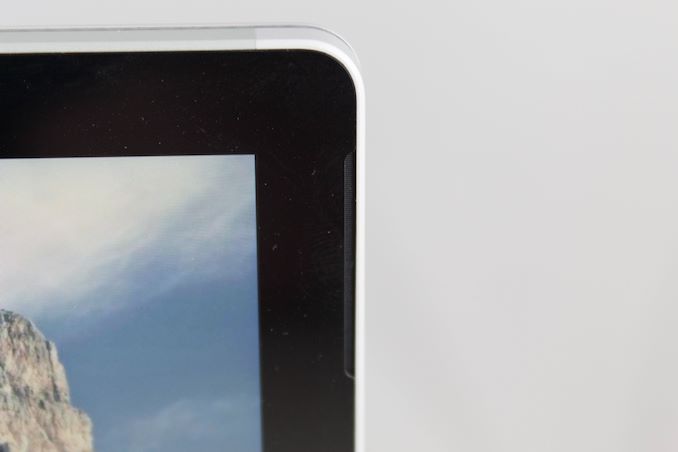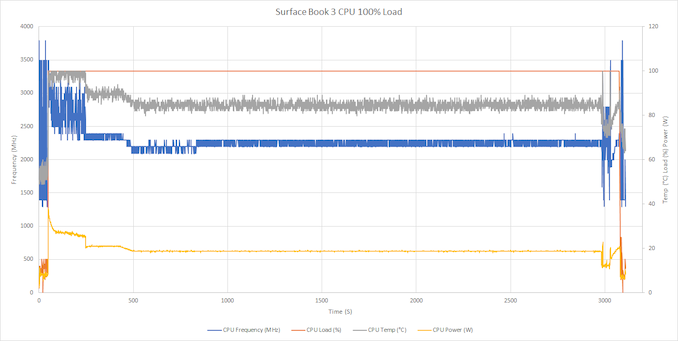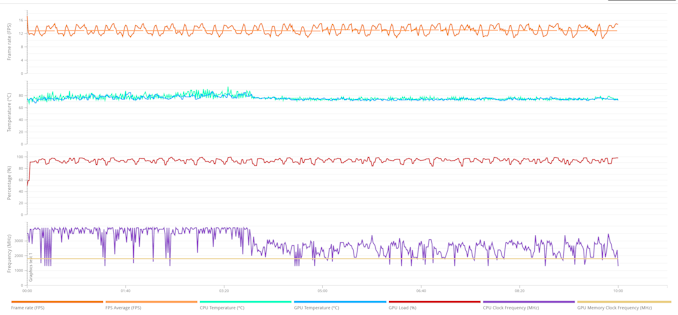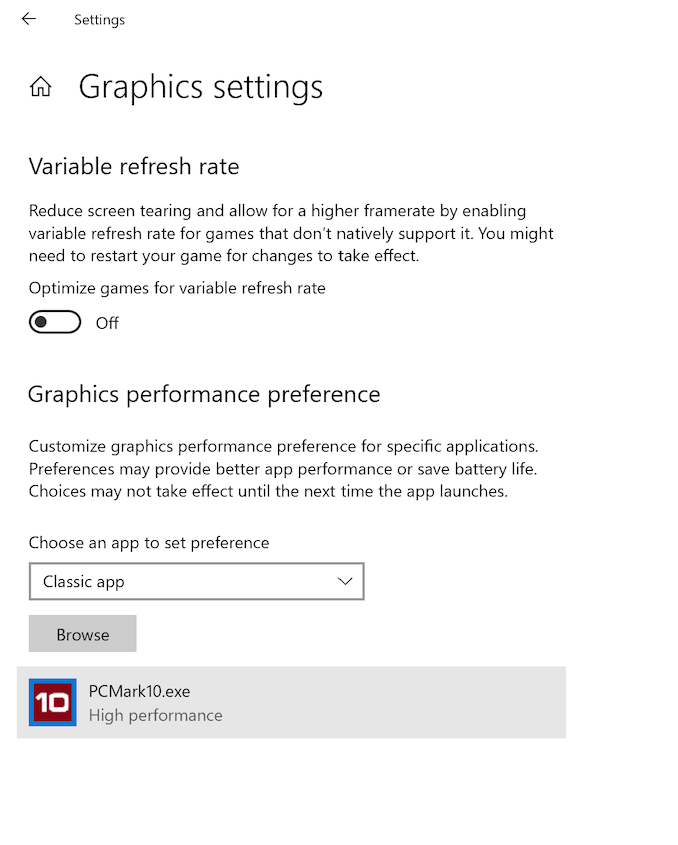The Microsoft Surface Book 3 (15-Inch) Review: A Refreshing Dip Into Ice Lake
by Brett Howse on June 3, 2020 9:00 AM ESTWireless
For the past several generations, Microsoft has leveraged Marvell networking adapters, unless the device had LTE, in which case they tended to use Qualcomm. Unfortunately, both were prone to unreliability and could not keep up with sustained transfer speeds like the latest Intel wireless solutions. Now that Wi-Fi 6 is upon us, the trend seems to be for everyone to use Intel wireless, including the Surface lineup. The Surface Book 3 features the Intel AX201 Wi-Fi 6 network adapter, which is a 2x2:2 design with the full 160 MHz channel width support.

The speeds are fantastic, and Intel has continued offering their very solid drivers too, so reliability has been top-notch. Although competition is always welcome, in the PC space there is really one standout wireless solution, and this is it.
Audio
Microsoft outfits the Surface Book 3 with front-facing stereo speakers featuring Dolby Atmos. As is typical of the Surface speakers, they blend almost seamlessly into the display bezel meaning they are almost invisible to the eye. There are also dual far-field microphones for dictation, or conferencing.
Sound quality of the speakers is excellent, and although they only achieved around 73dB(A) of SPL, the range of the speakers were quite impressive.
Thermals
The two-zone thermals of the Surface Book 3 mean that the temperature of the CPU will not impact the GPU, and vice versa. It also means that Microsoft has more room for a larger GPU, which we’ve seen the results of in our GPU testing. The CPU side with the Core i7-1065G7 has a thermal design of 15 Watts, meaning the processor is designed for a stead-state thermal load of 15 Watts, but with Intel’s aggressive Turbo, processors will draw much more than that for short bursts. On the GPU side, NVIDIA rates the GTX 1660 Ti Max-Q at between 65 and 80 Watts, depending on implementation.
The Surface Book 3 was subjected to a full CPU stress test, while monitoring the frequency and power draw of the processor. Interestingly, the processor very quickly bumps into the 100°C thermal limit, causing the processor to throttle at the start of the test during the PL1 stage of the CPU, which peaks at about 38 Watts maximum and 100°C. When PL1 ends and the processor moves into PL2, the power draw drops to a steady state value of around 19 Watts. So the Surface Book 3 can easily handle the full TDP of the processor, but it does not quite have enough to handle the full limit Microsoft implemented for PL1. This likely means there is not enough heatsink mass to handle the initial burst, although there is enough dissipation to handle the processor under load. As a comparison point, the Surface Laptop 3 with the same processor managed about 43 Watts at PL1 and it never quite reached the 100°C thermal cut-off, and then had a steady state of over 20 Watts. The overall cooling system is unsurprisingly not quite as capable as a more traditional laptop design, at least for the processor.
On the GPU front the Surface Book 3 also performs quite well. Unfortunately, our normal data logging tool was unable to read the GTX 1660 Ti, so instead we ran 20 loops of the 3DMark Fire Strike stress test. The GPU temperatures peaked at around 85° and settled in around 75°, with consistent FPS throughout the 20 loops.
One of the most amazing things about the Surface Book 3 thermals is how much performance there is considering the noise level. At full load after over an hour of use, the Surface Book 3 registered at only 43 dB(A) measured one inch over the trackpad. The tone of the noise is also low enough that it is very easy to live with. Despite not being able to get peak performance out of the CPU for a short window, the cooling system still does a great job and without much noise at all.
Software
One of the best perks of the Surface lineup is that there is no extra software installed to deal with, unless you include the unfortunate fluff that has started shipping directly in Windows. But as Surface is Microsoft’s device lineup, the Surface team also tends to bring new tech to Windows. For the Surface Laptop 3, that is the ability to choose the graphics adapter for each program directly in the Windows Settings. Previously, the NVIDIA Control Panel was required.
Branding of classic applications and UWP applications aside, it is nice to see this brought into Settings since it would be available for all GPU vendors and not require a proprietary tool.
Microsoft also includes the Surface App where you can see details about your device, battery levels of connected Surface peripherals, and get support.
Most laptops ship with some sort of tool for this function now, but the Surface one definitely has more polish than most.















125 Comments
View All Comments
zepi - Thursday, June 4, 2020 - link
How was batterylife in tablet mode without the base?Brett Howse - Friday, June 5, 2020 - link
Sorry I had tested that but forgot to add it to the graphs. It's there now.Wrong_again - Thursday, June 4, 2020 - link
It seems like an unpopular opinion but tablet devices should not have tiny bezels. For reasons that seem obvious to me.Retycint - Thursday, June 4, 2020 - link
The iPad Pro manages to have smaller bezels while not significantly affecting the usability. Smaller bezels does not necessarily mean tiny bezelss.yu - Thursday, June 4, 2020 - link
There's clearly a gap between this and "tiny". Also, again, the XPS 13 2N1 has a perfectly functional screen with arguably "tiny" bezels.PeachNCream - Thursday, June 4, 2020 - link
Tablets aren't really even a thing anymore. Hardly any company makes a credible attempt at producing one outside of the usual iFruits and Microsoft (I guess Google has Chrome-based hardware too if you like giving your personal information to the creepiest company on the planet). There are still a few 2-in-1 systems around and ultra low budget Android devices, plus a couple of laptops with questionably glossy touchscreens for reasons only the OEM can fully understand, but in general terms, tablets - Windows ones moreso than others - have been taken out back and shot, then tossed into a shallow grave with a bunch of other tech fads that failed to take enduring root.It is unexpected to watch Microsoft continue to release new models in a form factor that is laying in the desert, gasping its last parched air before failing to pull a Clint Eastwood-style survival montage. They already transitioned partly to clamshell designs to hedge the Surface brand name. It really is odd to see them clinging to the touch-everywhere bad old days of Windows 8.
lazybum131 - Thursday, June 4, 2020 - link
"It really is odd to see them clinging to the touch-everywhere bad old days of Windows 8."If only Microsoft actually did, then the tablet experience with Win 10 wouldn't be so poor. On Windows pure and detachable tablets aren't strong because the tablet experience just isn't good or polished even for built-in basic functions, let alone the barren app Store. Add in the slow progress on low-tdp chips that would actually enable portable designs.
lmcd - Thursday, June 4, 2020 - link
Intel's Lakefield could change the story there -- aside from the Intel tax with the experimental-technology surcharge, it could fit in 8 inch tablets. Based on the Surface Neo delay, I'd assume it's using a Lakefield chip.Microsoft's lack of good tablet software in the store boils down to the .NET team absolutely ignoring everything the Windows team would prioritize. Windows 10X doubles down on UWP while the .NET team hasn't released an up-to-date AOT compiler and C# project format in over 2 years.
Deicidium369 - Friday, June 5, 2020 - link
I will probably use the tablet mode on the 13 2-in-1 about as much as on the previous model - not much at all - but when needed (stocking up at a Spec's type place for a party) it is very useful. But yeah the time of the tablets looks to be over.Deicidium369 - Friday, June 5, 2020 - link
would be obvious 1st time it got dropped...